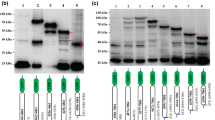Abstract
The L1 retrotransposon codes for a unique bicistronic mRNA, which serves as a transposition intermediate and as a template for the synthesis of two proteins. According to preliminary data, the translation of both cistrons is initiated by a noncanonical mechanism. The L1 mRNA was translated in rabbit reticulocyte lysate (RRL), a standard system widely used to study the eukaryotic mechanisms of protein synthesis. Translation yielded not only the expected products, but also several products of aberrant translation initiation on internal AUG codons. Such products are not generated during in vivo translation of the L1 mRNA. When RRL was supplemented with a cytoplasmic extract of HeLa cells, the aberrant products were not synthesized, while the first cistron was translated with the same efficiency. The efficiency of translation of the second cistron became substantially lower, corresponding to the situation in vivo. These and other experiments clearly demonstrated that the new combined system RRL + HeLa is far more adequate for studying the mechanisms of translation initiation than the standard RRL system.
Similar content being viewed by others
References
Ostertag E.M., Kazazian H.H., Jr. 2001. Biology of mammalian L1 retrotransposons. Annu. Rev. Genet. 35, 501–538.
Pelham H.R., Jackson R.J. 1976. An efficient mRNA-dependent translation system from reticulocyte lysates. Eur. J. Biochem. 67, 247–256.
Sambrook J., Russell D. 2001. Molecular Cloning: A Laboratory Manual. 3d ed. N.Y.: Cold Spring Harbor Lab. Press.
Leibold D.M., Swergold G.D., Singer M.F., Thayer R.E., Dombroski B.A., Fanning T.G. 1990. Translation of LINE-1 DNA elements in vitro and in human cells. Proc. Natl. Acad. Sci. USA. 87, 6990–6994.
McMillan J.P., Singer M.F. 1993. Translation of the human LINE-1 element, L1Hs. Proc. Natl. Acad. Sci. USA. 90, 11533–11537.
Meerovitch K., Svitkin Y.V., Lee H.S., Lejbkowicz F., Kenan D.J., Chan E.K., Agol V.I., Keene J.D., Sonenberg N. 1993. La autoantigen enhances and corrects aberrant translation of poliovirus RNA in reticulocyte lysate. J. Virol. 67, 3798–3807.
Hunt S.L., Hsuan J.J., Totty N., Jackson R.J. 1999. unr, a cellular cytoplasmic RNA-binding protein with five cold-shock domains, is required for internal initiation of translation of human rhinovirus RNA. Genes Dev. 13, 437–448.
Jia X.Y., Scheper G., Brown D., Updike W., Harmon S., Richards O., Summers D., Ehrenfeld E. 1991. Translation of hepatitis A virus RNA in vitro: Aberrant internal initiations influenced by 5′ noncoding region. Virology. 182, 712–722.
Brown B.A., Ehrenfeld E. 1979. Translation of poliovirus RNA in vitro: Changes in cleavage pattern and initiation sites by ribosomal salt wash. Virology. 97, 396–405.
Domer A.J., Semler B.L., Jackson R.J., Hanecak R., Duprey E., Wimmer E. 1984. In vitro translation of poliovirus RNA: Utilization of internal initiation sites in reticulocyte lysate. J. Virol. 50, 507–514.
Dasso M.C., Jackson R.J. 1989. On the fidelity of mRNA translation in the nuclease-treated rabbit reticulocyte lysate system. Nucleic Acids Res. 17, 3129–3144.
Jackson R.J. 1991. Potassium salts influence the fidelity of mRNA translation initiation in rabbit reticulocyte lysates: Unique features of encephalomyocarditis virus RNA translation. Biochim. Biophys. Acta. 1088, 345–358.
Svitkin Y.V., Ovchinnikov L.P., Dreyfuss G., Sonenberg N. 1996. General RNA binding proteins render translation cap-dependent. EMBO J. 15, 7147–7155.
Terenin I.M., Dmitriev S.E., Andreev D.E., Royall E., Belsham G.J., Roberts L.O., Shatsky I.N. 2005. A cross-kingdom internal ribosome entry site reveals a simplified mode of internal ribosome entry. Mol. Cell. Biol. 25, 7879–7888.
Dorokhov Y.L., Skulachev M.V., Ivanov P.A., Zvereva S.D., Tjulkina L.G., Merits A., Gleba Y.Y., Hohn T., Atabekov J.G. 2002. Polypurine (A)-rich sequences promote cross-kingdom conservation of internal ribosome entry. Proc. Natl. Acad. Sci. USA. 99, 5301–5306
Ergun S., Buschmann C., Heukeshoven J., Dammann K., Schnieders F., Lauke H., Chalajour F., Kilic N., Stratling W.H., Schumann G.G. 2004. Cell type-specific expression of LINE-1 open reading frames 1 and 2 in fetal and adult human tissues. J. Biol. Chem. 279, 27753–27763.
Hohjoh H., Singer M.F. 1996. Cytoplasmic ribonucleoprotein complexes containing human LINE-1 protein and RNA. EMBO J. 15, 630–639.
Deragon J.M., Sinnett D., Labuda D. 1990. Reverse transcriptase activity from human embryonal carcinoma cells NTera2D1. EMBO J. 9, 3363–3368.
Ostertag E.M., Kazazian H.H., Jr. 2001. Twin priming: A proposed mechanism for the creation of inversions in L1 retrotransposition. Genome Res. 11, 2059–2065.
Kozak M. 1987. At least six nucleotides preceding the AUG initiator codon enhance translation in mammalian cells. J. Mol. Biol. 196, 947–950.
Grunert S., Jackson R.J. 1994. The immediate downstream codon strongly influences the efficiency of utilization of eukaryotic translation initiation codons. EMBO J. 13, 3618–3630.
Author information
Authors and Affiliations
Additional information
Original Russian Text © S.E. Dmitriev, N.V. Bykova, D.E. Andreev, I.M. Terenin, 2006, published in Molekulyarnaya Biologiya, 2006, Vol. 40, No. 1, pp. 25–30.
Presented for publication by I.N. Shatskii
Rights and permissions
About this article
Cite this article
Dmitriev, S.E., Bykova, N.V., Andreev, D.E. et al. Adequate system for studying translation initiation on the human retrotransposon L1 mRNA in vitro. Mol Biol 40, 20–24 (2006). https://doi.org/10.1134/S0026893306010043
Received:
Issue Date:
DOI: https://doi.org/10.1134/S0026893306010043




